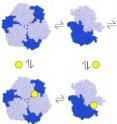Could new discovery about a shape-shifting protein lead to a mighty 'morpheein' bacteria fighter?
A small molecule that locks an essential enzyme in an inactive form could one day form the basis of a new class of unbeatable, species-specific antibiotics, according to researchers at Fox Chase Cancer Center. Their findings, highlighted on the cover of the June 23 issue of the journal Chemistry & Biology, take advantage of an emerging body of science regarding "morpheeins" – proteins made from individual components that are capable of spontaneously reconfiguring themselves into different shapes within living cells.
The researchers discovered a small molecule, which they have named morphlock-1, binds the inactive form of a protein known as porphobilinogen synthase (PBGS), an enzyme used by nearly all forms of cellular life. The functioning form of PBGS is built from eight identical component parts – in what is called an octamer configuration – and is essential among nearly all forms of life in the processes that enable cells to use energy. The other configuration is made of six parts – or a hexamer configuration – and serves as a "standby" mode for the protein.
"As the name suggests, morphlock-1 essentially locks the hexamer configuration into place, preventing its protein subunits from reconfiguring into the active assembly," says lead investigator Eileen Jaffe, Ph.D, a Senior Member of Fox Chase. "Targeting morpheeins in their inactive assemblies provides an entirely new approach to drug discovery."
While their study was performed using a pea plant-version of PBGS, the researchers have reason to believe the principle could apply to bacterial versions of PBGS as well. "Using morphlock-1 as a base, we are seeking to fine tune the molecule so that it blocks just the bacterial version of the PBGS enzyme, " Jaffe says.
"Because PBGS is so crucial for life, the part of the enzyme where chemistry happens is highly conserved through evolution," Jaffe says, meaning that an all-around PBGS-inhibiting drug would harm bacteria, peas and people alike. The area where the potential drug binds to the hexamer form of the protein, however, has been found to differ among species, depending how far the organisms have evolved from each other.
When PBGS is in its inactive hexamer form, there is a small cavity on the surface of the assembled complex. Using computer docking techniques, Jaffe and her Fox Chase colleagues identified a suite of small molecules predicted to bind to this cavity.
The researchers then bought and tested a selection of these molecules in the lab to see if any of them stabilized the pea PBGS in its hexamer assembly. One inhibitor in particular, given the name morphlock-1, potently drove the formation of the hexamer in pea PBGS, but not in that of humans, fruit flies, or the infectious bacteria Pseudomonas aeruginosa, or Vibrio cholerae, the latter of which causes cholera. Morphlock-1 is a potent inhibitor of pea PBGS, but not of the PBGS from these other organisms.
Jaffe coined the term "morpheein" in 2005 after a study of the structure of PBGS revealed its shape-shifting tendencies. While initially met with skepticism because the existence of morpheeins contradicts some classic concepts about protein structure and function, subsequent studies have reinforced that PBGS (and perhaps other proteins) exhibits this behavior. According to Jaffe, this study is the first to make use of alternate morpheein shapes as a potential strategy for drug discovery, in general, particularly for antibiotics.
"Multi-drug resistance drives the need for developing new antibiotics," Jaffe says. "Since drugs that stabilize the inactive PBGS hexamer need not be chemically similar to each other, it will be difficult for the bacterium to develop complete resistance to a cocktail of such compounds."
Source: Fox Chase Cancer Center
Other sources
- Could new discovery about a shape-shifting protein lead to a mighty 'morpheein' bacteria fighter?from Biology News NetFri, 20 Jun 2008, 20:07:18 UTC
- Could new discovery about a shape-shifting protein lead to a mighty 'morpheein' bacteria fighter?from PhysorgFri, 20 Jun 2008, 17:28:38 UTC
- Could New Discovery About A Shape-shifting Protein Lead To A Mighty 'Morpheein' Bacteria Fighter?from Science DailyFri, 20 Jun 2008, 17:28:14 UTC
